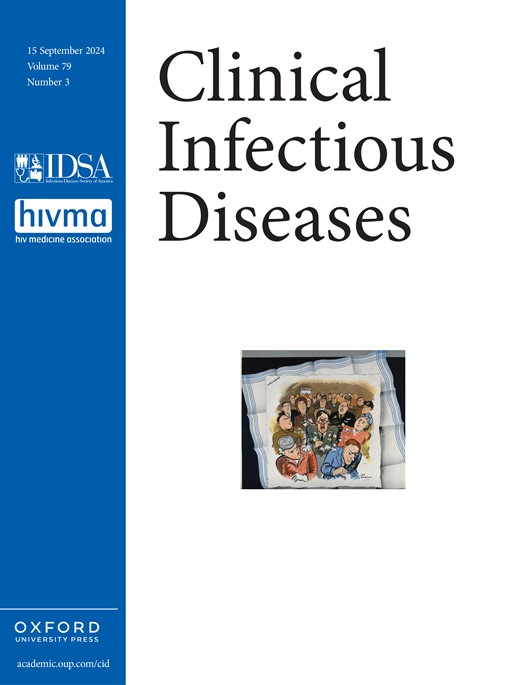
Cover image

Volume 79, Issue 3, 15 September 2024
In the Literature
In the Literature
State-of-the-Art Review
Executive Summary: State-of-the-Art Review: Evaluation and Management of Pelvic Osteomyelitis in Stage IV Pressure Injuries: A Multidisciplinary Collaborative Approach
Voices of ID
Firsts
Invited Commentary
Doff Thy Gown—Shedding Contact Precautions for COVID-19
Antimicrobial Resistance and Stewardship
A Novel Risk-Adjusted Metric to Compare Hospitals on Their Antibiotic Prescribing at Hospital Discharge
We developed a model using electronically available data to predict antibiotics prescribed at hospital discharge. A risk-adjusted metric based on this model showed that some hospitals are more successful in reducing antibiotic overuse at this transition of care.
Revolutionizing Daptomycin Dosing: A Single 7–11-Hour Sample for Pragmatic Application
Performance of Urinalysis Parameters in Predicting Urinary Tract Infection: Does One Size Fit All?
Bacterial Infections
Distinct Clinical Endpoints of Staphylococcus aureus Bacteraemia Complicate Assessment of Outcome
We found no overall association between metastatic complications (predominantly musculoskeletal) and death due to Staphylococcus aureus bacteraemia. Each endpoint was associated with distinct host, clinical and microbiologic features. Age and multi-morbidity were associated with death but not metastatic infection.
Lower Specificity of the European Society of Cardiology 2023 Diagnostic Criteria for Infective Endocarditis When Spondylodiscitis Is Regarded as a Vascular Phenomenon
Clinical Trials
Effects of Losartan on Patients Hospitalized for Acute COVID-19: A Randomized Controlled Trial
Angiotensin receptor blockers (ARBs) should not be used for the treatment of acute COVID-19 infections due to safety concerns. ARBs should be used cautiously in patients hospitalized with pneumonia.
Does Adjunctive Clindamycin Have a Role in Staphylococcus aureus Bacteremia? A Protocol for the Adjunctive Treatment Domain of the Staphylococcus aureus Network Adaptive Platform (SNAP) Randomized Controlled Trial
This article reports the protocol for the adjunctive treatment domain of the Staphylococcus aureus Network Adaptive Platform (SNAP) trial. The adjunctive treatment domain aims to test the effectiveness of adjunctive clindamycin in patients with Staphylococcus aureus bacteremia.
COVID-19/SARS CoV-2
Assessment of the Impact of RNase in Patients With Severe Fatigue Related to Post-Acute Sequelae of SARS-CoV-2 Infection: A Randomized Phase 2 Trial of RSLV-132
While the primary endpoint of the study was not significant, the data suggest eliminating latent viral RNA by increasing serum RNase activity may improve fatigue in patients with post-acute sequelae of SARS-CoV-2. Women may respond better to this approach than men.
Identifying Veterans Who Benefit From Nirmatrelvir-Ritonavir: A Target Trial Emulation
Nirmatrelvir-ritonavir was associated with reductions in 30-day hospitalizations and deaths in older veterans, those at highest predicted risk for severe outcomes, and immunocompromised groups. Benefit was not observed in younger veterans or groups at lower predicted risk for hospitalization and death.
Rapid Wane and Recovery of XBB Sublineage Neutralization After Sequential Omicron-based Vaccination in Solid Organ Transplant Recipients
Emerging Infections
Exploring the Resurgence of a Neglected Disease: Lessons From the 2023–2024 Mpox Outbreak in Rio de Janeiro, Brazil
A Second Mpox Outbreak in Brazil: A Call for Action to Guarantee Equity in Access to Health Innovations
Endovascular Infections
Cutibacterium Species Valvular and Cardiac Device–Related Infective Endocarditis: Contemporary Data From the GAMES Prospective Cohort (2008–2023)
This study describes the clinical features and prognosis of Cutibacterium spp. valvular and cardiac device–related infective endocarditis in a nationwide prospective cohort over a 16-year period and examines the impact of molecular techniques and the new Duke-ISCVID criteria on diagnosis.
Fungal Infections
Treatment Outcomes Among Patients With a Positive Candida Culture Close to Randomization Receiving Rezafungin or Caspofungin in the ReSTORE Study
This preplanned subgroup analysis of the ReSTORE trial supports rezafungin efficacy and safety versus caspofungin for the treatment of candidemia and/or invasive candidiasis in patients with a positive culture close to randomization, who may represent patients with more serious infections.
Risk Factors and Outcome Associated With Fungal Infections in Patients With Severe Burn Injury: 10-year Retrospective IFI-BURN Study
Independent risk factors for invasive fungal diseases (IFDs) are indoor burn, deep burn surface area, and severity score. IFD is independently associated with a risk of death.
Hepatitis
Optimization of Mother-to-Child Hepatitis B Virus Prevention Program: Integration of Maternal Screening and Infant Post-Vaccination Serologic Testing
Our study provides real-world evidence concerning the implementation and impact of mother-to-child hepatitis B prevention programs using infant–mother pairs to assess hepatitis B surface antigen prevalence, including maternal antiviral prophylaxis as the standard of care.
Vertical Transmission of Hepatitis C Virus Among Women With a History of Injection Opioid Use
Cumulative Tenofovir Exposure Among Patients With HIV/Hepatitis B Coinfection With Differential Viral Suppression
HIV/AIDs
Clinical Predictors and Outcomes of Invasive Anal Cancer for People With HIV in an Inception Cohort
People with human immunodeficiency virus with both cytological anal high-grade squamous intraepithelial lesion and nadir CD4 cell count ≤200/µL face 13-fold increased anal cancer risk compared with those lacking both. Anal cancer mortality (21%) occurred exclusively among stage IIIA patients.
Development of a Machine Learning Modeling Tool for Predicting HIV Incidence Using Public Health Data From a County in the Southern United States
We applied machine learning to predict HIV incidence in a high-incidence US county using deidentified public health data, focusing on sociodemographic factors and sexually transmitted infections. The models showed high accuracy, suggesting the potential for guiding public health strategies.
Lower Insulin Sensitivity Through 36 Months of Life With in Utero HIV and Antiretroviral Exposure in Botswana: Results From the Tshilo Dikotla Study
In utero human immunodeficiency virus (HIV) and antiretroviral (ARV) exposure is associated with lower insulin sensitivity through the first 36 months of life, indicating metabolic disturbances and potentiallly poorer metabolic health later in life for children with perinatal HIV/ARV exposure.
Pediatric and Maternal Infectious Diseases
Characterization of Gram-negative Bloodstream Infections in Hospitalized Australian Children and Their Clinical Outcomes
A total of 931 gram-negative bloodstream infection episodes involving 818 children were studied. The children were typically young and medically complex. Enterobacterales comprised 71%, of which 22% demonstrated third-generation cephalosporin resistance. Bloodstream infections caused by Enterobacterales resistant to third-generation cephalosporin were associated with worse outcomes.
Social Factors Associated With Congenital Syphilis in Missouri
Congenital syphilis pregnancy outcomes in Missouri are strongly associated with inadequate prenatal care, substance use, housing instability, and interactions with the justice system. Future studies should evaluate the role of social support in prevention and management of congenital syphilis.
Respiratory Infections
Comparison of QuantiFERON Gold In-Tube Versus Tuberculin Skin Tests on the Initiation of Tuberculosis Preventive Therapy Among Patients Newly Diagnosed With HIV in the North West Province of South Africa (the Teko Study): A Cluster Randomized Trial
This cluster-randomized trial demonstrated that integrating QuantiFERON Gold In-Tube testing into routine HIV care led to substantially higher testing and preventive treatment for tuberculosis infection than the standard of care. This trial was conducted in South Africa with 2232 patients in the analysis.
The Impact of Pretransplant Respiratory Virus Detection on Posttransplant Outcomes in Children Undergoing Hematopoietic Cell Transplantation
In pediatric myeloablative allogeneic hematopoietic cell transplantation recipients, pretransplant symptomatic upper respiratory tract infections, including human rhinovirus virus, is associated with increased duration of hospitalization after transplant in univariable models.
Photo Quiz
Fever and Extensive Blistering in a Patient With Atopic Dermatitis
When Location and Timing Are at the Heart of the Diagnosis
Viral Infections
Incidence of Influenza-related Medical Encounters and the Associated Healthcare Resource Use and Complications Across Adult Age Groups in the United States During the 2015–2020 Influenza Seasons
Changes in influenza incidence generally occur gradually as individuals age, with increases in hospitalization incidence beginning around 50 years of age. Influenza infections frequently result in serious secondary complications such as pneumonia and are associated with frequent antibiotic and antiviral prescriptions.
Consensus Definitions of Cytomegalovirus (CMV) Infection and Disease in Transplant Patients Including Resistant and Refractory CMV for Use in Clinical Trials: 2024 Update From the Transplant Associated Virus Infections Forum
The existing definitions of cytomegalovirus (CMV) infection and disease for use in clinical trials have been updated. The update is based on new developments including the introduction of clinically significant CMV infection and developments in diagnosis of CMV disease.
Cytomegalovirus Disease: Fine-Tuning Clinical Trial Enrollment and Standardization
Correspondence
Clinical Testing Guidance for Histoplasmosis in Patients With Community-Acquired Pneumonia for Primary and Urgent Care Providers: Role of Enzyme Immunoassay Histoplasma-Specific Immunoglobulin G and Immunoglobulin M Testing
Clinical Testing Guidance for Histoplasmosis in Patients With Community-acquired Pneumonia for Primary and Urgent Care Providers: Commentary on Enzyme Immunoassay Histoplasma Antibody Testing
Nirmatrelvir and Ritonavir Combination in COVID-19 Patients With Advanced Chronic Kidney Disease
Contemporary Management of Staphylococcus aureus Bacteremia: Some Additional Considerations for Clinicians
In Memoriam: Dr Adaora Alise Adimora, 1956–2024
Correction
Correction to: Treatment for First Cytomegalovirus Infection Post–Hematopoietic Cell Transplant in the AURORA Trial: A Multicenter, Double-Blind, Randomized, Phase 3 Trial Comparing Maribavir With Valganciclovir
State-of-the-Art Review
Evaluation and Management of Pelvic Osteomyelitis in Stage IV Pressure Injuries: A Multidisciplinary Collaborative Approach
This article explores the management of pelvic osteomyelitis in patients with stage IV pressure injuries, emphasizing the need for multidisciplinary care and highlighting the challenges faced by healthcare providers due to the lack of high-quality evidence to guide best practices.















